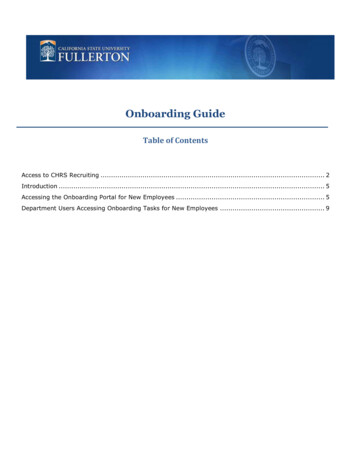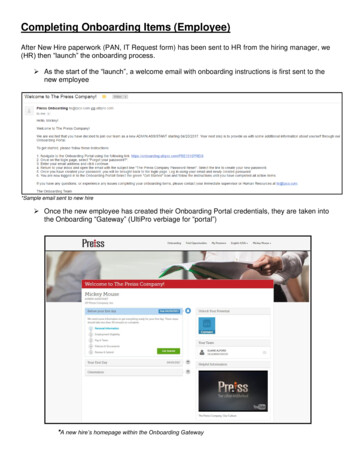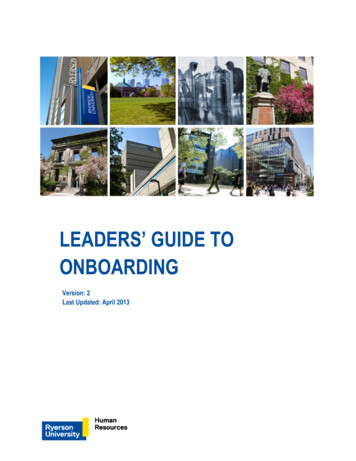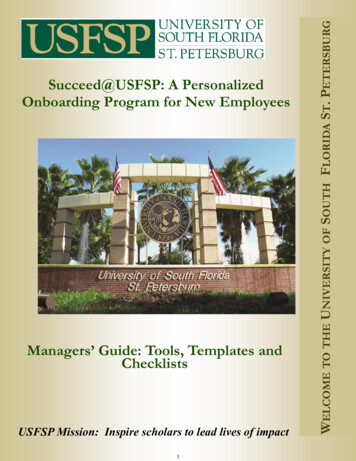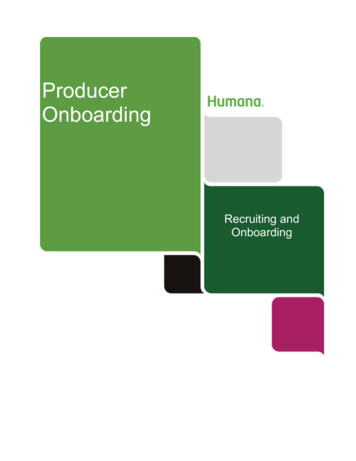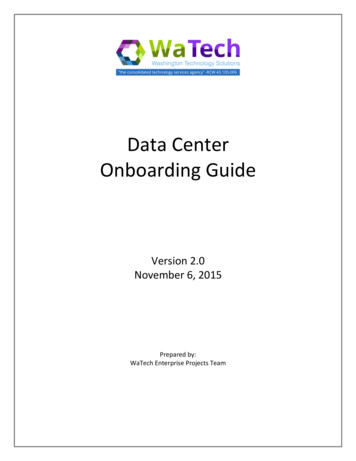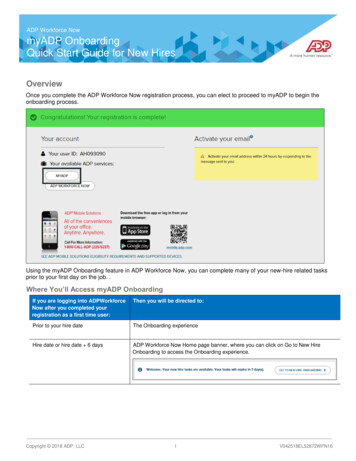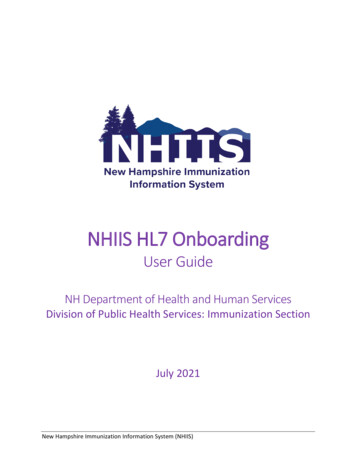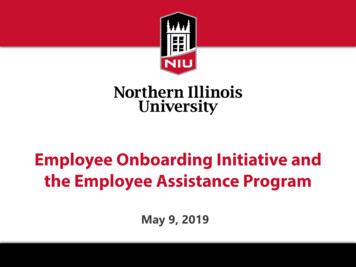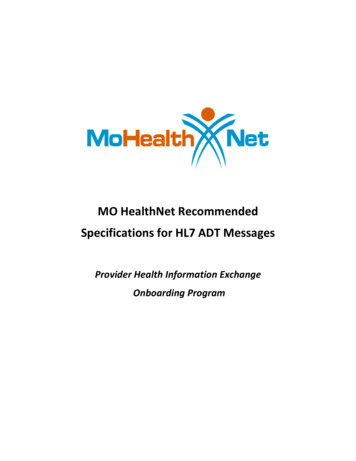
Transcription
MO HealthNet RecommendedSpecifications for HL7 ADT MessagesProvider Health Information ExchangeOnboarding Program
Purpose: These specifications are recommended by MO HealthNet forhospitals, emergency departments, and urgent care settings licensed underhospitals. Ambulatory settings that are capable of sending ADTs areencouraged to use these specifications.MO HealthNet thanks its partner, the Missouri Hospital Association and theHospital Industry Data Institute, for its assistance on Admit, Discharge, Transfer(ADT) message specifications.
Specifications for HL7 ADT MessagesOverview and Assumptions These specifications for ADT messages are most closely aligned with the PHIN MESSAGINGGUIDE FOR SYNDROMIC SURVEILLANCE: EMERGENCY DEPARTMENT, URGENT CARE,INPATIENT AND AMBULATORY CARE SETTINGS Release 2.0 April 21, 2015. Submitters who are able to redirect a copy of a compliant syndromic surveillance feed should beable to meet these specifications with minimal modifications. ALL messages constrained by this guide that are produced as a result of a single patientencounter must have the same value for PV1-19.1 (Visit ID). Messages constrained by this guide that are produced as a result of different patientencounters must not have the same value for PV1-19.1 (Visit ID). Outpatient and ambulatory visits can be included if the submitter’s interface can include“outpatient” visits in PV1-2 (Patient Class). This guide is consistent with Health Level Seven International (HL7) standards, but the fulldetail will not be covered in this document. Please consult http://www.hl7.org/ for moreinformation. Message segments not addressed in this guide can be supported, but are not required.Additional consideration will be needed if a facility is submitting additional information.Basic HL7 TermsBASIC HL7 TERMSTERMDEFINITIONMessageA message is the entire unit of data transferred between systems in a single transmission.It is a series of segments in a defined sequence, with a message type and a trigger event.SegmentA segment is a logical grouping of data fields. Segments within a defined message may berequired or optional and may occur only once or may be allowed to repeat. Each segmentis named and is identified by a segment ID, a unique three‐character code.FieldA field is a string of characters. Each field has an element name. The segment it is in and itssequence within the segment identify each field. Usage and cardinality requirements aredefined in the Segment Definitions.Component A component is one of a logical grouping of items that comprise the contents of a coded orcomposite field. Within a field having several components, not all components arenecessarily required to be populated.Data typeA data type restricts the contents and format of the data field. Data types are given a two‐or three‐letter code. Some data types are coded or composite types with severalcomponents. The applicable HL7 data type is listed in each field definition.DelimitersThe delimiter values are defined in MSH‐1 and MSH‐2 and are used throughout themessage. The default delimiters are: ‐ Field Separator ‐ Component SeparatorPage 1
Specifications for HL7 ADT MessagesDate Time FormatThe number of characters populated (excluding the time zone specification) specifies the precision.Example: 199904 specifies April 1999.Example: 199904011503 specifies April 1 1999 at 1503Format: YYYY[MM[DD[HH[MM[SS[.S[S[S[S]]]]]]]]][ /-ZZZZ].Thus:a) only the first four are used to specify a precision of "year"b) the first six are used to specify a precision of "month"c) the first eight are used to specify a precision of "day"d) the first ten are used to specify a precision of "hour”e) the first twelve are used to specify a precision of "minute”f) the first fourteen are used to specify a precision of "second”g) the first sixteen are used to specify a precision of "one tenth of a second”h) the first nineteen are used to specify a precision of "one ten thousandths of a second”The time zone ( /-ZZZZ) is represented as /-HHMM offset from Coordinated Universal Time (UTC)(formerly Greenwich Mean Time (GMT)), where 0000 or -0000 both represent UTC (without offset).The specific data representations used in the HL7 encoding rules are compatible with ISO 88241987(E). Note that if the time zone is not included, the time zone is assumed to be that of the localtime zone of the sender. Also note that a DTM or TS valued field with the HHMM part set to "0000"represents midnight of the night extending from the previous day to the day given by the YYYYMMDDpart.Message AcknowledgementsHL7 message acknowledgments are a valuable tool for effective interface messaging, and will be usedroutinely, unless the submitter is unable to support. The submitter will communicate their ability toreceive messages acknowledgements in the Message Header (MSH) segment. The messageacknowledgement will be communicated in the Message Acknowledgement (MSA) segment.Usage of Message ElementsUsage indicates whether the message element (segment, segment group, field, component, orsubcomponent) is Required, Optional, Not Supported, or Conditional in the corresponding messageelement.UsageRRequired, Must always be populatedRE Required, but may be empty. If the sender has data, it must be sent. The receiver will notraise an error or warning if the data is not sent.CConditionally RequiredCE Conditionally Required but may be empty. The receiver will not raise an error or warning ifthe data is not sent.XNot supportedOOptional; this information is highly desired, but not required.Page 2
Specifications for HL7 ADT MessagesMessage and Event Types Supported Admission, Discharge and Transfer (ADT) messages version 2.5.1 with compatibility for version2.3.1 messages are supported with this specification. In this specification, only A01, A03, A04 and A08 event types are supported.Event TypeA01ADT/ACK ‐ Admit/visit notificationA04ADT/ACK ‐ Register a patientA03ADT/ACK ‐ Discharge/end visitA08ADT/ACK ‐ Update patient informationHL7 Message Type Requirements By Patient Care SettingUsage of Message Trigger TypesHospital providing inpatient careHospitals providing emergency care ONLYUrgent and non‐urgent ambulatory careA04RRRA01RRRA03RRRA08RRRRequired Segments for ADT MessagingBelow is a breakdown of basic ADT message format by segment.Basic ADT Message RequirementsSegmentNameMSHMessage HeaderEVNPIDPV1Event TypePatient IdentificationPatient VisitPV2OBXPatient VisitAdditionalInformationObservation / tionInformation explaining how to parse and process themessage information, includes identification of messagedelimiters, sender, receiver, message type, timestamp,etc.Trigger event information for receiving applicationPatient identifying and demographic informationInformation related to this visit at this facility includingthe nature of the visit, critical timing information and aunique visit identifier.Admit Reason information.Clinical information and observations. This segment isrepeatable.Admitting Diagnosis and, optionally, Working and FinalDiagnosis information. This segment is repeatable.Information relative to various types of proceduresperformed. This segment is repeatable.Information about insurance policy coverage information.This segment is repeatable.UsageRRRRRERREOREPage 3
Specifications for HL7 ADT MessagesSegment DefinitionsMessage Header (MSH) Segment - The MSH Segment is used to define the intent, source,destination, and some specifics of the syntax of the message. This segment includes identification ofmessage delimiters, sender, receiver, message type, timestamp, etc.Message Header SegmentFieldField NameMSH‐1.1Field SeparatorMSH‐2Encoding CharactersUsageRRMSH‐3Sending ApplicationOMSH‐4.1Sending Facility ‐Namespace IDRMSH‐4.2Sending Facility ‐Universal IdentifierRMSH‐4.3Sending Facility ‐Universal ID TypeRMSH‐5.1MSH‐6MSH‐7Receiving ApplicationReceiving FacilityDate/Time of MessageOORMSH‐9.1Message CodeRMSH‐9.2MSH‐9.3MSH‐10Trigger EventMessage StructureMessage Control IDRRRMSH‐11MSH‐12MSH‐15Processing IDVersion IDAccept AcknowledgmentTypeApplicationAcknowledgment TypeMessage Profile IdentifierRRCEMSH‐16MSH‐21 CERCommentsDefault value is (ASCII 124)Default values are \& (ASCII 94, 126, 92, and 38,respectively)This field uniquely identifies the sending application amongall other applications within the network enterpriseMSH‐4 uniquely identifies the facility associated with theapplication that sends the message. RecommendOrganizational Name/Legal Business Name associated withUniversal ID. NPI or CCN recommendedNPI or CCN recommendedhttps://npidb.org/ or ccn/8acm‐5n8y/dataNPI or CCNThis field contains the date/time that the sending systemcreated the message. If the time zone is specified, it will beused throughout the message as the default time zone.This field contains the message type, trigger event, and themessage structure ID for the message. Expected values'ADT' or 'ACK'Expected values 'A01', 'A03', 'A04' and 'A08'HL7 table 0354This field contains a number or other identifier thatuniquely identifies the message. The receiving systemechoes this ID back to the sending system in the Messageacknowledgment segment (MSA)“P” for Production, “D” for Debug or “T” for Training.Expected value is '2.5.1'HL7 table 0155: HL7 defined: Accept/applicationacknowledgment conditionsHL7 table 0155: HL7 defined: Accept/applicationacknowledgment conditionsExpected values are 'PH SS‐Ack' or 'PH SS‐NoAck'Example for A01 Admit transaction with Acknowledgment:MSH \& DownTownProcessing 2231237890 NPI 201808071400 ADT A01 ADT A01 Q123459876 P 2.5.1 AL ER PH SS-AckPage 4
Specifications for HL7 ADT MessagesEvent Type (EVN) Segment - The EVN segment is used to communicate trigger eventinformation to receiving applications.Event Type (EVN) SegmentFieldField NameEVN‐1Event Type CodeUsageREEVN‐2Recorded Date/TimeREVN‐7.1Event Facility ‐Namespace IDREVN‐7.2Event Facility –Universal IDREVN‐7.3Event Facility –Universal ID TypeR CommentsTable PHVS EventType SyndromicSurveillance.Expected values 'A01', 'A03', 'A04' and tion?oid 2.16.840.1.114222.4.11.6048System date/time when the transaction wascreated/generated from the original treating facility. Ifdata flows through an intermediary or third party, theintermediary must keep the original date/time oftransmission.EVN‐2 (Recorded Date/Time) does not have to equalMSH‐7 (Date/Time of Message)This field identifies the location where the patient wasactually treated; recommend Organizational Name/LegalBusiness Name associated with Universal ID.https://npidb.org/NPI or CCN recommendedhttps://npidb.org/ or ccn/8acm‐5n8y/dataNPI or CCNExample that shows the use of the NPI for the facility identifier:EVN 201806071300.1234-0500 GreaterNorthMedCtr 4356012945 NPIPatient Identification (PID) Segment - The PID Segment is used as the primary means ofcommunicating patient identification information. This segment contains pertinent patientidentifying and demographic information.Patient Identification (PID) SegmentFieldField NamePID‐1Set ID ‐ PIDUsageRPID‐3.1Patient IdentifierRPID‐3.4Assigning AuthorityNamespaceRECommentsThe sequence number shall be one. Expected value is '1'.This segment is not repeatable.PID‐3 The Unique Patient Identifier (Medical Record #)occurs in the 1st component of the CX data type. The 5thcomponent, the Identifier Type Code, defines the type ofidentifier used in the 1st component. This field allowsmultiple patient identifiers to be passed in the message.See example below.Organization that assigned the medical record numberPage 5
Specifications for HL7 ADT MessagesPID‐3.5Identifier Type CodeRTable PHVS IdentifierType /ViewValueSet.action?oid 2.16.840.1.114222.4.11.3597Missouri Syndromic Messaging Guide has this field as REThe first field name contains the primary or legal name ofthe patient. Therefore, the name type code (PID.5.7)should be “L “(Legal), when populated.PID‐3.6PID‐5.1Assigning FacilityPatient Last NameORPID‐5.2PID‐5.3PID‐5.4Patient First NamePatient Middle NamePatient Name SuffixROOMiddle name or initial is acceptablePatient last name suffix. Ex: SR or JRPID‐5.5Patient Name PrefixOPatient name prefix. Ex: MRS or DRPID‐5.7Name Type CodeOMissouri Syndromic Messaging Guide has this field asRequired. Expected value is "L" from HL7 table 0200PID‐7PID‐8Date/Time of BirthAdministrative SexREREPID‐10.1Race ‐ IdentifierREPID‐10.2Race ‐ TextOPID‐10.3Race –Name of Coding tient Address Street 1Patient Address Street 2Patient Address CityPatient Address StateREOREREPID‐11.5Patient Address ZipREPID‐11.6Patient Address CountryREPID‐11.7Address TypeOTable PHVS Gender SyndromicSurveillance. Expectedvalues 'F', 'M', 'O', 'U. Does not include 'N' or on?oid 2.16.840.1.114222.4.11.3403Note: allows for multiple race identifiers (see example)HL7 table 0005: User defined Race orPHVS RaceCategory on?oid 2.16.840.1.114222.4.11.836Recommend standardized description associated withcode in PID 10.1.Condition Rule: Required if an identifier is provided incomponent 1. Expected Value: “CDCREC”Required Missouri, RE in federal specification. TablePHVS State FIPS tion?oid 2.16.840.1.114222.4.11.830Reference USPS tables. Expected format is 5 digit or 9digit (Example 54321 or 54321‐1234)Three character country code ‐ PHVS Country ISO .action?id ing patient primary (current) address. Addresstype PHVS AddressType on?id 01D34BBC‐617F‐DD11‐B38D‐00188B398520Page 6
Specifications for HL7 ADT MessagesPID‐11.9County/Parish CodeREPID‐13Phone Number ‐ HomeREPID‐18PID‐19Patient Account NumberSocial Security NumberOREPID‐22.1Ethnic Group ‐ IdentifierREPID‐22.2Ethnic Group ‐ TextOPID‐22.3Ethnic Group – Name ofCoding SystemCECondition Rule: Required if an identifier is provided incomponent 1. Expected Value: “CDCREC”PID‐29CECondition Rule: Required if PID‐30 is 'Y'.PID‐30Patient Death Date andTimePatient Death IndicatorCEPID‐33Last Update Date/TimeOPID‐34Last Update FacilityO‘Y' patient is deceased, 'N' patient is not deceased.Condition Rule: Expect 'Y' if PV1‐36 is '20', '40', '41', or'42'This field contains the last update date and time for thepatient’s identifying and demographic data, as defined inthe PID segment.This field identifies the facility of the last update to apatient’s identifying and demographic data, as defined inthe PID segment. County FIPS code expected. PHVS County FIPS lueSet.action?id y home number. No repetitions. Preferredlocation is in components PID 13.6 & 13.7. Rarely used,but extension is supported in PID 13.8Required if Visit Number not available.Not supported in federal spec, but required by Missourilaw for syndromic reporting. Expected format isunformatted 9 digits.Value set that indicates whether the patient is Hispanic ornot. While the standard allows this field to repeat, onlyexpecting one of the mutually exclusive ethnicity codes tobe in the message. Table PHVS EthnicityGroup ueSet.action?oid 2.16.840.1.114222.4.11.837Recommend standardized description associated withcode in PID 22.1.Example PID Segment that shows a male patient with multiple patient identifiers and multiplerace codes.PID 1 2111000222 NEMedCtr&1234567890&NPI MR 12345789 NEMedCtr&1234567890&NPI LR EVERYPERSON JOE A JR MR L M 2054-5 Black or AfricanAmerican CDCREC 20289 Asian CDCREC Decatur 13 30303 USA M 13121 100221223 NEMedCtr&1234567890&NPI AN 2135-2 Hispanic or Latino CDCRECPage 7
Specifications for HL7 ADT MessagesPatient Visit (PV1) Segment - The PV1 segment is used by Registration/Patient Administrationapplications to communicate information on a visit-specific basis.Patient Visit (PV1) SegmentFieldField NamePV1‐1Set ID ‐ PV1UsageREPV1‐2Patient ClassRPV1‐3PV1‐4Assigned Patient LocationAdmission TypeOREPV1‐6PV1‐7.1Prior Patient LocationAttending ing Doctor –Assigning Authority forIdentifierHospital ServiceAdmit SourcePV1‐19.1Visit Number ‐ IdentifierRPV1‐19.4Visit Number –Assigning AuthorityVisit Number –Identifier Type CodeOOPV1‐36Visit Number –Assigning FacilityDischarge DispositionPV1‐44PV1‐45Admit Date TimeDischarge Date TimeRCEPV1‐19.5PV1‐19.6OORCECommentsThe sequence number shall be one. Expected value is '1'.This segment is not repeatable.Limit values only to E: Emergency; I: Inpatient; O:Outpatient per TablePHVS PatientClass /ViewValueSet.action?oid 2.16.840.1.114222.4.11.3404Expected values 'E', 'A', 'L', 'R', 'U' from TablePHVS AdmissionType HL7 n?id 08D34BBC‐617F‐DD11‐B38D‐00188B398520Unique Physician (Provider) Identifier ‐ Attending Doctoris the XCN datatype where the ID number is in the firstcomponent and the assigning authority is in the 9thcomponent as a HD (hierarchical designator) type.Prefer NPITable 0069HL7 table 0023: User defined Admit Source. In the US,this field is used on UB92 FL20 “Source of Admission”.The unique identifier for a patient visit. A visit is definedas a discrete or unique clinical encounter within a servicedepartment or location.Table 0363Table PHVS IdentifierType /ViewValueSet.action?oid 2.16.840.1.114222.4.11.3597Condition Rule: Required for A03; Required; may beempty for A08. Not supported in A01 & A04 messagetypes. This specification uses discharge dispositioncodes shown below (see table on page 13) that is basedon Table PHVS DischargeDisposition HL7 n?oid 2.16.840.1.114222.4.11.915Condition Rule: Required A03; Required; may be emptyfor A08. Not supported in A01 & A04 message types.Page 8
Specifications for HL7 ADT Messages Example PV1 Segment for an Inpatient:PV1 1 I E 112345 Familyname Givenname DR MD NEMedCtr&1234567890&NPI MED 7 2222 001 GreaterNorthMedCtr&4356012945&NPI VN 201908171200Patient Visit Additional Information (PV2) Segment - The PV2 segment is a continuation ofvisit-specific information and is the segment where the Admit Reason is passed.Patient Visit Additional Information (PV2) SegmentFieldField NameUsage CommentsPV2‐3Admit ReasonREThis field contains the short description of the providers’reason for patient admission.NOTE: Admit Reason may be coded (CE.1 – CE.3) or Freetext (CE.2.) The implementation supports all 3 value setsfor PV2‐3 (Admit Reason): ICD‐9 CM AdministrativeDiagnosis Codes; ICD‐10 codes; SNOMED Disease orDisorder ‐ 64572001 Domain Codes.If only Free Text is used, it is communicated incomponent 3.2. If a drop‐down menu of canned admitreason text is used, it is communicated in component 3.2. Example PV2 Segment for an Inpatient:PV2 11530004 Brittle Diabetes SCT (SNOMED encoded)PV2 O24.4 Diabetes Mellitus arising in pregnancy I10 (ICD10 encoded)PV2 Diabetes Mellitus (Free text or text selected from a drop-down menu)Diagnosis (DG1) Segment - The DG1 segment contains patient diagnosis information of varioustypes. Admitting, Working and Final Diagnosis types are supported.Diagnosis (DG1) SegmentFieldField NameDG1‐1Set ID ‐ DG1UsageRDG1‐3.1Diagnosis Code ‐ IdentifierRDG1‐3.2Diagnosis Code ‐ TextRDG1‐3.3Name of Coding SystemRDG1‐5Diagnosis Date/TimeOCommentsThis segment is repeatable. This field contains thenumber that identifies the transaction. For the firstoccurrence of the segment the sequence number shall be1, for the second occurrence it shall be 2, etc.The implementation supports all 3 value sets for PV2‐3(Admit Reason): Administrative Diagnosis Codes for ICD‐9CM and ICD‐10 codes; SNOMED Disease or Disorder ‐64572001 Domain Codes.This component contains a description for the conceptidentified in DG1‐3.1.The expected values is in the set (‘I10’, ‘I9CDX’, ‘SCT’).Code systems identifiers from HL7 Table ion?oid 2.16.840.1.114222.4.11.3338This field contains the date/time that the diagnosis wasdetermined. This field desirable for final diagnosis.Page 9
Specifications for HL7 ADT MessagesDG1‐6 Diagnosis TypeRThis field contains a code that identifies the type ofdiagnosis being sent. Diagnosis Type shall be either A, For W (Admitting, Final or Working)Example DG1 Segment:DG1 1 R50 FEVER OF OTHER AND UNKNOWN ORIGIN I10 W (Working diagnosis fromICD10)DG1 2 16932000 NAUSEA AND VOMITING SCT W (Working diagnosis from SNOMED-CT)DG1 1 J14 PNEUMONIA DUE TO HEMOPHILUS INFLUENZA I10 201812271700 F (Finaldiagnosis from ICD10)Insurance (IN1) Segment - The IN1 segment is used to communicate health plan information.Insurance (IN1) SegmentFieldField NameIN1‐1Set ID ‐ IN1UsageRIN1‐2Insurance Plan IDRIN1‐3Insurance Company IDRIN1‐15Plan TypeO CommentsThis segment is repeatable. This field contains thenumber that identifies the transaction. For the firstoccurrence of the segment the sequence number shall be1, for the second occurrence it shall be 2, etc.This field contains a unique identifier for the insuranceplan.Note: This field is HL7‐required to use the IN1 segment. Ifan insurance plan ID is unavailable, use UNK UNKNOWN NULLFL to meet the requirement topopulate the field with a CE value type for HL7compliance.This field contains unique identifiers for the insurancecompany. The assigning authority and identifier typecode are strongly recommended for all CX data types.Note: This field is HL7‐required to use the IN1 segment. Ifan insurance company identifier is unavailable, use UNKNOWN UNKNOWN to meet the requirement topopulate the field as a CX value type for HL7 compliance.Highly desired. This field contains the coding structurethat identifies the various plan types, for example,Medicare, Medicaid, Blue Cross, HMO, etc.NOTE: Suggesting use of the table: Source of PaymentTypology action?oid 2.16.840.1.114222.4.11.3591Example IN1 Segment:IN1 1 SP Self-Pay INSUR PLAN CODESYSID Self-Pay 81 Page 10
Specifications for HL7 ADT MessagesProcedures (PR1) Segment - The PR1 segment is used to carry information relative to varioustypes of procedures performed. This segment is optional.Procedures (PR1) SegmentFieldField NamePR1‐1Set ID ‐ PR1UsageRPR1‐3.1Procedure Code ‐IdentifierRPR1‐3.2Procedure Code ‐ TextREPR1‐3.3Name of Coding SystemCEPR1‐5Procedure Date/TimeR CommentsThis segment is repeatable. This field contains thenumber that identifies the transaction. For the firstoccurrence of the segment the sequence number shall be1, for the second occurrence it shall be 2, etc.This field contains a unique identifier assigned to theprocedure. The implementation supports all 3 value sets:Concept value from ICD‐9CM Procedure code , Volume 3Concept value from ICD‐10‐PCS InternationalClassification of Diseases, 10th Revision, ProcedureCoding System (ICD‐10‐PCS), andCurrent Procedural Terminology (CPT ), Fourth Edition(CPT‐4).This component contains a description for the conceptidentified in PR1‐3.1.The expected values is in the set (‘I10’, ‘I9CDX’, ‘C4’).Code systems identifiers from HL7 Table ion?oid 2.16.840.1.114222.4.11.3338This field contains the date/time that the procedure wasperformed.Example PR1 SegmentPR1 1 49650 HERNIA REPAIR, LAPAROSCOPIC C4 201808081816 (procedure from CPT-4)OBSERVATION/RESULT (OBX) SEGMENT - The OBX Segment in the ADT Message is used totransmit observations related to the patient and visit. This is an optional segment, but if a dataelement is carried in an OBX and usage is ‘Required’, the segment and its fields must be populated.The Set ID number within a given set of OBX segments in a message and are required to besequential.Observation (OBX) SegmentFieldField NameOBX‐1Set ID ‐ OBXUsageROBX‐2RValue TypeCommentsThis field contains the sequence number. Set ID numbersthe repetitions of the segments. Example:OBX 1 .OBX 2 .OBX 3 .This field contains the format of the observation value inOBX.Note: Identifies the structure of data in observation value(OBX.5) Expected values in the setPage 11
Specifications for HL7 ADT MessagesOBX‐3.1Observation ‐ IdentifierROBX‐3.2Observation ‐ TextOOBX‐3.3Name of Coding SystemCEOBX‐5Observation ValueREOBX‐6UnitsCEOBX‐11Observation Results StatusROBX‐14Observation Date/TimeO (‘TS’, ‘TX’, ‘NM’, ‘CWE’, ‘XAD’) from the value on?oid 2.16.840.1.114222.4.11.6057This field contains a unique identifier for the observation.These are observation identifiers associated withsyndromic surveillance that are contained in the t.action?oid 2.16.840.1.114222.4.11.3589This component contains a description for the conceptidentified in OBX‐3.1.This should be provided if OBX3.1 is valued.This field contains the value observed by the observationproducer. OBX‐2‐value type contains the data type forthis field according to which observation value isformatted.When an observation’s value is measured on acontinuous scale (OBX‐5), one must report themeasurement units within the units field of the OBXsegment (OBX‐6). If OBX.2 (Value Type) is valued “NM”,the units field is required.HL7 table 0085 Observation Results ction?id ed value is ‘F’This field is the observation date‐time which is thephysiologically relevant date‐time or the closestapproximation to that date‐time.Example OBX SegmentsOBX 1 CWE 8661-1 CHIEFCOMPLAINT:FIND:PT:PATIENT:NOM:REPORTED LN STOMACHACHE F 201812171531OBX 2 NM 21612-7 AGE TIME PATIENTREPORTED LN 43 a YEAR UCUM F 201812171531OBX 3 NM 11289-6 BODYTEMPERATURE:TEMP:ENCTRFIRST:PATIENT:QN LN 99.1 [degF] FARENHEIT UCUM F 201812171658OBX 4 NM 59408-5 OXYGEN SATURATION:MFR:PT:BLDA:QN:PULSEOXIMETRY LN 95 % PERCENT UCUM F 201812171658OBX 5 TS 11368-8 ILLNESS OR INJURY ONSET DATE ANDTIME:TMSTP:PT:PATIENT:QN LN 20181215 F 201812171658OBX 6 TX 54094-8 TRIAGENOTE:FIND:PT:EMERGENCYDEPARTMENT:DOC LN Pain arecurrent cramping sensation. F 201802121114Page 12
Specifications for HL7 ADT MessagesCode Set ReferencesAll value sets associated with this specification are available me Syndromic%20SurveillanceTable 0112 Discharge Disposition Code – Shown below, this table has been modified to includeadditional mapped values that align with UB04 codes.Table 0112 Discharge DispositionValue DescriptionSourceComments0102Discharged to home or self‐care (routine discharge)Discharged/transferred to another short term generalhospital for inpatient careHL7HL7030405Discharged/transferred to skilled nursing facility (SNF)Discharged/transferred to an intermediate care facility (ICF)Discharge or transfer to a designated cancer center orchildren’s hospitalHL7HL7HL706Discharged/transferred to home under care of organizedhome health service organizationHL70708Left against medical advice or discontinued careDischarged/transferred to home under care of Home IVproviderHL7HL709202130Admitted as an inpatient to this hospitalExpiredDischarged/transferred to court/law enforcementStill patient or expected to return for outpatient servicesHL7HL7HL7HL74041Expired at homeExpired in a medical facility; e.g., hospital, SNF, ICF, or freestanding hospiceHL7HL742435051616263646566697081Expired ‐ place unknownTo Federal Health Care FacilityHospice ‐ HomeHospice ‐ Medical FacilityTo hospital‐based swing‐bedTo another Rehabilitation FacilityTo a Long Term Care hospitalTo a Nursing FacilityTo a Psychiatric FacilityTo a Critical Access Hospital (CAH)To a Designated Disaster Alternative Care SiteTo another type of institutionHome/Self Care with Planned Acute Care Assigned to match UB0482To an Acute Care Facility with Planned Acute CareReadmissionHL7Assigned to match UB04Assigned to match UB04Page 13
Specifications for HL7 ADT Messages83To Skilled Nursing Facility (SNF) with Planned Acute CareReadmissionHL7Assigned to match UB0484To Intermediate Care Facility (ICF) with Planned Acute CareReadmissionHL7Assigned to match UB0485To a Designated Cancer Center or Children’s Hospital withPlanned Acute Care ReadmissionHL7Assigned to match UB0486Home Health Care with Planned Acute Care ReadmissionHL7Assigned to match UB0487To a Law Enforcement Agency with Planned Acute CareReadmissionHL7Assigned to match UB0488To Federal Health Care Facility with Planned Acute CareReadmissionHL7Assigned to match UB0489To Hospital‐Based Swing Bed with Planned Acute CareReadmissionHL7Assigned to match UB0490To an Inpatient Rehab Facility(IRF) with Planned Acute CareReadmissionHL7Assigned to match UB0491To a Long Term Care hospital with Planned Acute CareReadmissionHL7Assigned to match UB049293To a Nursing Facility with Planned Acute Care ReadmissionTo a Psychiatric Facility with Planned Acute CareReadmissionHL7HL7Assigned to match UB04Assigned to match UB0494To a Critical Access Hospital (CAH) with Planned Acute CareReadmissionHL7Assigned to match UB0495To another type of institution with Planned Acute CareReadmissionHL7Assigned to match UB0499100101102103104105106107108109Invalid CodeDischarged for Other ReasonsDischarged to Care o
GUIDE FOR SYNDROMIC SURVEILLANCE: EMERGENCY DEPARTMENT, URGENT CARE, INPATIENT AND AMBULATORY CARE SETTINGS Release 2.0 April 21, 2015. . (ADT) messages version 2.5.1 with compatibility for version 2.3.1 messages are supported with this specification. In this specification, only A01, A03, A04 and A08 event types are supported.

